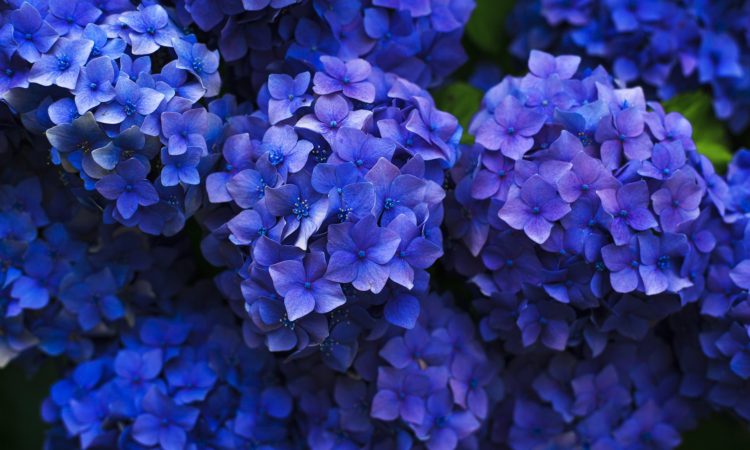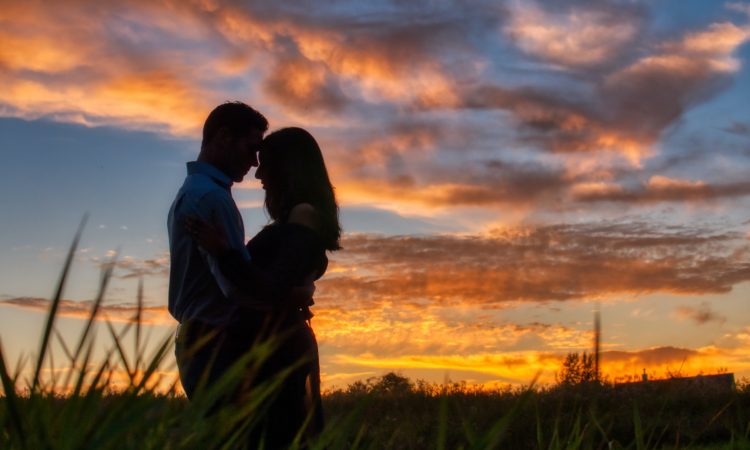This post is also available in:


Konnichiwa, adventurers! Whether you’ve made Japan your home or you’re just discovering its wonders, there’s one thing you absolutely have to do: dive into the beauty of Japanese tradition. What, may you ask, would that be? Well, visiting some famous temples, why not start with Tokyo’s famous temples!
Here, in this article, join me as we take a tour of some of Tokyo’s most well-known temples and shrines, where traditional customs coexist with modern living.
I will introduce 10 recommended temples and shrines to you in Tokyo that are worth visiting at least once in your lifetime. We will go through Meiji Shrine, Sensoji Temple, Gotokuji Temple, Nezu Shrine, Tennoji Temple, and more.
Before we proceed, let me inform you that this beautiful, centuries-old architecture will awe you with its wooden structure. Let’s dive in and be amazed.
Tokyo Famous Temples and Shrines to Put on Your Bucketlist
1. Meiji Shrine at Meijijingumae
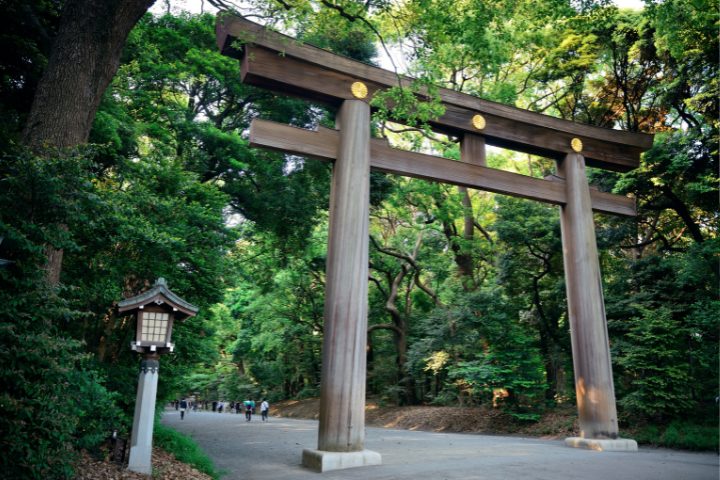 Image credit: Canva
Image credit: Canva
First on our list of famous temples and shrines in Tokyo is Meiji Jingu! Built in 1920, it is dedicated to the deified spirits of Emperor Meiji and his consort, Empress Shoken. This is one of Japan’s most popular shrines, and it is said to welcome more than three million visitors for hatsumode (the first prayers of the year).
Meiji Jingu is a much-needed tranquil oasis in Tokyo, surrounded by 100,000 trees planted during the shrine’s construction. To get to the main shrine complex, take the tree-lined 10-minute walk from the Southern Entrance near Harajuku Station or the Northern Entrance near Yoyogi Station.
On the way to the shrine from the Harajuku entrance, you’ll find the Meiji Jingu Museum, designed by the famous architect Kuma Kengo. This museum displays personal items from the Meiji Emperor.
The Inner Garden requires a fee to enter and is popular in June during Iris season. There’s also a small well called Kiyomasa’s Well, a popular power spot that is said to bring luck.
Popular Points:
□ Natural oasis in Tokyo.
□ Easily accessible.
□ Popular spot for wedding ceremonies.
□ Kiyomasa’s Well power spot
Popular Place To Pray For:
□ Harmonious marriage
Offer Prayers Time:
□ 5:00-18:30 (depends on the month, check the website here)
Access:
□ (JR) Harajuku Station, 2 min walk to the Torii gate, 10 minutes to the main shrine complex
□ (Chiyoda or Fukutoshin Line) Meijijingumae Station, 2 min walk to the Torii gate, 10 minutes to the main shrine complex
2. Sensoji Temple at Asakusa
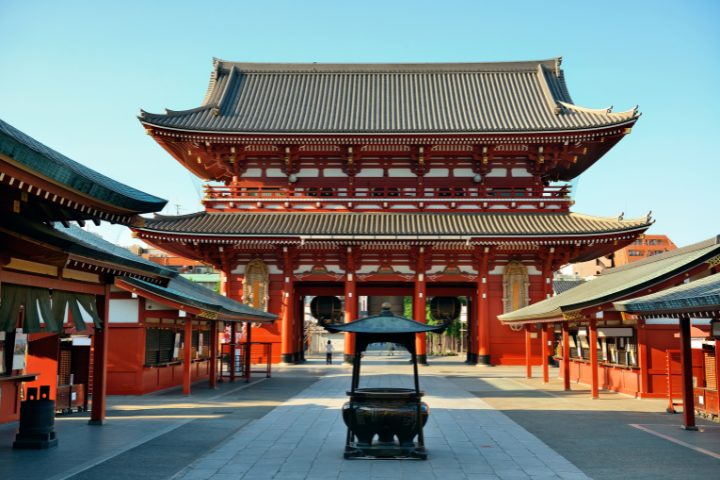 Image credit: Canva
Image credit: Canva
Sensoji is the oldest and most famous temple in Tokyo. You’ll often see it depicted when as a representative of the popular tourist location Asakusa. About thirty million people visit this temple every year.
Perhaps the most famous aspect of the temple is the Kaminari-mon Gate, originally built in 942 and rebuilt in 1960 after a fire. Statues of Fujin (the god of wind) and Raijin (the god of thunder) are enshrined in the gate to guard the temple from natural disasters.
It’s said Sensoji was built to enshrine a statue of Kannon, the goddess of mercy, found in the Sumida River in 628 AD by two fishermen.
Popular Points:
□ Kaminari-mon – a symbol of Asakusa and Tokyo
□ The five-story pagoda makes for a great picture
□ The many food and souvenir stalls in Nakamise-dori on the walk up to the main temple
□ The jokoro, giant incense burner – cover yourself with the smoke to purify mind, body and soul
Popular Place To Pray For:
□ Economic fortune
□ Good luck
Offer Prayers Time:
□ 06:00 to 17:00. (The temple opens at 06:30 between October and March).
Access:
□ (Ginza Line) Asakusa Station with 3 min walk
3. Gotokuji Temple at Gotokuji
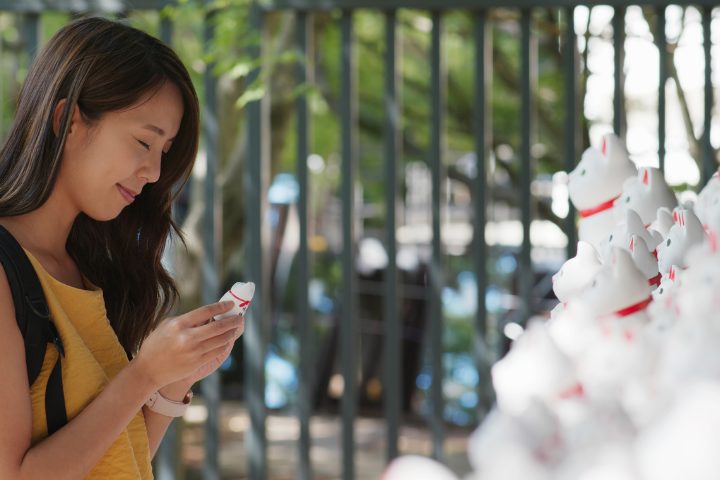 Image credit: Canva
Image credit: Canva
Gotokuji is another temple famous throughout Japan and overseas. What makes this temple popular are the thousands of Maneki-neko, the “beckoning cat” figurine, which is said to bring good fortune. In fact, Gotokuji is the supposed origin of these maneki-neko, linked by a famous legend.
The legend states that in the 17th century, a samurai lord traveling the region took shelter from a storm under a large tree near the temple. He saw the temple monk’s cat waving to him with one paw. As he got closer to investigate the cat, the tree behind him was completely destroyed by lightning. The lord, grateful to the cat for saving his life, became a temple patron and rebuilt it in honour of the lucky cat. Now, visitors offer figurines of this cat in an act of “offering” to bring good fortune. Why not take a trip and try it yourself?
You may notice there are different versions of the maneki-neko. A cat with the right hand beckoning is to ask for economic fortune, and a beckoning left hand is to invite customers into (entertainment businesses such as restaurants, hotels, etc.)
Popular Points:
□ The thousands of maneki-neko figures.
Popular Place To Pray For:
□ Wishing for your family’s safety
□ Economic fortune
Name:
□ Gotoku Temple
Offer Prayers Time:
□ 6:00-18:00
Access:
□ (Odakyu Odawara Line) 10 minute walk from Gotokuji Station
4. Nezu Shrine at Sendagi
Nezu Shrine is famous as an important cultural property, as most of the structures remain from when they were built or rebuilt in 1706. It’s also one of the most photogenic shrines in Tokyo—surrounded by exquisite greenery, it features picturesque koi-filled ponds and pathways of small red torii gates.
In April, thousands of pink and white azaleas bloom over the shrine’s hills, making it a popular destination for photos and flower lovers.
Popular Points:
□ Torii gate pathways.
□ From April to May, thousands of azaleas bloom for a beautiful photo spot.
□ Good luck fortunes.
Popular Place To Pray For:
□ Matchmaking
□ Good luck
□ Academic achievements
Offer Prayers Time:
□ 6:00-17:00 (changes depending on the season).
Access:
□ (Chiyoda Line) 7 mins walk from Sendagi Station Exit 2
5. Tennoji Temple at Nippori
Tennoji is the oldest temple in Yanaka, a beautiful district with a long history. The grounds, which used to include the Yanaka Cemetery, feature a large ancient bronze Buddha and carefully kept greenery.
Tennoji was one of the temples famous for producing lottery tickets in the Edo Period (the other temples being Yushima Tenjin and Meguro Fudoryusenji Temple). The government permitted these lotteries for fundraising reasons, but they were eventually banned in the 19th century.
Tennoji Temple is home to one of the famous Yanaka Seven Gods of Fortune, the god Bishamonten (Vaiśravaṇa). As such, it is part of the Yanaka Seven Gods of Fortune Pilgrimage (the shichifukujin-meguri). These Seven Lucky Gods are popular in the Shitamachi of Tokyo, and visiting the enshrined gods and receiving stamps as part of a pilgrimage is a custom available at the start of the year.
Popular Points:
□ One of the Yanaka Shichifukujin (God of Fortune) spots
Popular Place To Pray For:
□ Good Fortune
Offer Prayers Time:
□ 9:00-17:00
Access:
□ (Chiyoda Line) Sendagi Station, 15 min walk
□ (JR) Nippori Station South Exit, 2 min walk
6. Hie Shrine at Akasaka
This shrine was built 700 years ago, enshrining the mountain God believed to provide household safety. Monkeys are believed to be guardians of the mountains, which is why you’ll see monkey guardians instead of the traditional dog statues, and amulets and ema with monkey symbols.
Hie Shrine is famous for the Sanno Festival in June, and for its “Thousand Torii Gates” of the Inari Shrine pathway
Popular Points:
□ “Thousand Torii Gates” of the Inari Shrine pathway.
□ Monkey guardian statues
□ Treasure Hall Gallery
□ Sanno Festival in June – one of three great festivals of the Edo Period (the festival parade is held on even-numbered years, alternating with the Kanda Festival).
Popular Place To Pray For:
□ Matchmaking
□ Prosperous business
Offer Prayers Time:
□ 6:00-17:00
Access:
□ (Chiyoda Line) Akasaka Station Exit 2, 3 min walk
□ (Nanboku or Ginza Line) Tameikesanno Station Exit 7, 3 min walk
7. Tokyo Daijingu at Iidabashi
Tokyo Daijingu was created as a branch of Ise Jingu so people could worship the major deities Amaterasu and Touyouke no Okami enshrined in Ise Jingu from afar in Tokyo. It’s also known as the place people had the very first Shinto-style wedding in Japan in 1900. This makes it a popular place for omamori charms for relationships and love.
Popular Points:
□ Good reputation for matchmaking
Popular Place To Pray For:
□ Matchmaking
Offer Prayers Time:
□ 6:00-21:00
Access:
□ (JR) Iidabashi Station, 5 min walk
8.Yasukuni Shrine at Kudanshita
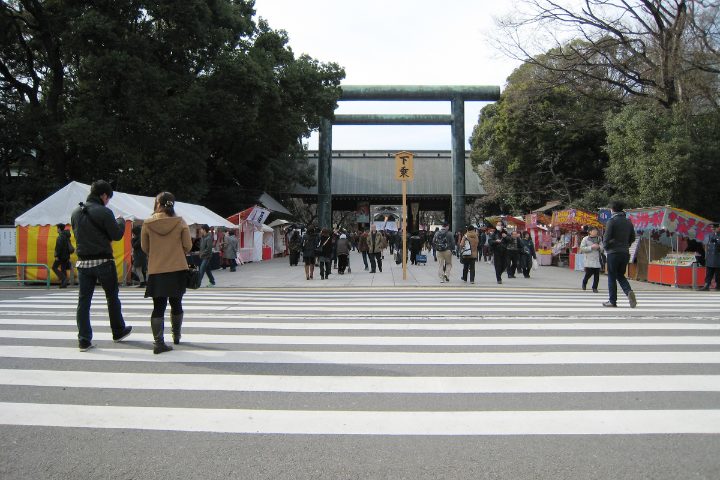 Image credit: Canva
Image credit: Canva
This Yasukuni Shrine is famous for commemorating Japan’s war dead in the form of written documents. There is a political controversy surrounding the shrine as since 1978, fourteen class A war criminals are commemorated among the 2.5 million people enshrined here.
The grounds have hundreds of cherry trees, making it a popular spot during the cherry blossom season. It is also home to Tokyo’s representative cherry blossom tree, used to determine the official start of the cherry blossom season in the captial.
Popular Points:
□ There is a military museum called “Yushukan”, and it’s very popular with information in English.
□ The biggest Tori gate in Japan you can see before you enter the divine space.
Popular Place To Pray For:
□ Good Fortune
Name:
□ Yasukuni Shrine
Offer Prayers Time:
□ 6:00-18:00 (17:00 in November to February).
Access:
□ (Tozai, Hanzomon, Toei Shinjuku Line) Kudanshita Station within 5 min walk
9. Atago Shrine at Kamiyacho
If you want your career to succeed, you should check out Atago Shrine. It’s known for it’s steep staircase “Shusse no Kaidan” which is said to grant success in business. The story says that Tokugawa Ieyasu issued an order for the beautiful plum blossoms near the main shrine to be brought to him. Many people failed but Magaki Heikuro succeeded in climbing the shrine steps on horseback and so the stairs became the “steps of success”.
The steps are so intimidating there’s even an elevator that leads to the main shrine. But if you want to succeed in your career, you’d better use the stairs.
Popular Points:
□ “Shusse no Kaidan” from the main gate.
Popular Place To Pray For:
□ Career success
Offer Prayers Time:
□ 9:00-16:00
Access:
□ (Hibiya Line) Kamiyacho Station within 5 min walk
□ (Ginza Line) Toranomon Station within 8 min walk
10. Hanazono Shrine at Shinjuku
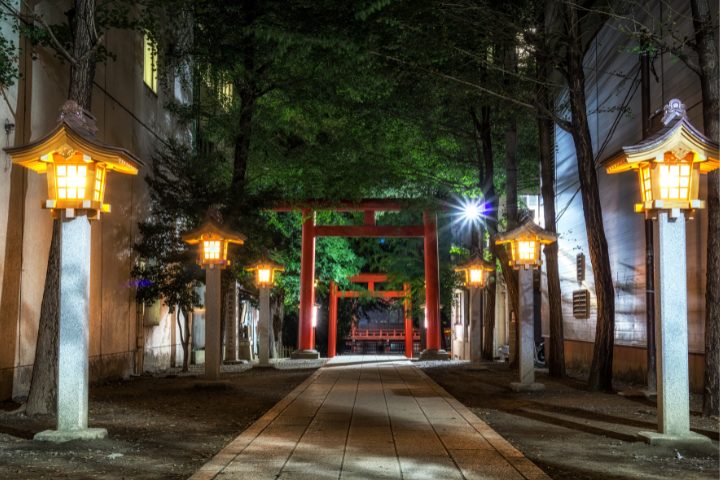 Image credit: Canva
Image credit: Canva
Hanazono Shrine is the most important shrine in Shinjuku as it guards the locals, local businesses and merchants. The shrine is dedicated to Inari Okami, the deity of trade and worldly sucess. One of the sub-shrines is Geino Asama Shrine, the shine dedicated to success of performers. If you’re interested in show-business entertainment, you should visit this shrine as many actors and performers visit this shrine to pray and donate money for good luck in their performances. Isn’t it surprising how even in the busy streets of Shinjuku you can find a Tokyo famous shrine?
Popular Points:
□ There are lots of charms written by many show-business entertainers.
Popular Place To Pray For:
□ Success for show-business
□ Blessing with children
Name:
□ Hanazono Shrine
Offer Prayers Time:
□ 8:00-20:00
Access:
□ (JR) Shinjuku Station East Exit within 7 min walk
□ (Marunouchi Line) Shinjuku Sanchome Station within 3 min walk.
Visiting Tokyo Famous Temples and Shrines
Be sure to add these Tokyo famous temples and shrines to your list. There are plenty more to explore and admire, please be sure to do your research on proper temple and shrine etiquette. May everyone who walks through their gates be inspired and made to feel better.
We wish you all the luck and happiness!
Related Articles:
- Discovering Our Top 5 Hidden Nature Spots in Tokyo
- Why Visiting Onsen in Summer Is a Must-Do! Try These Summer Onsen Destinations in Japan
- Top 5 Places Near Tokyo to Cool off This Summer
Featured Image credit: Canva


